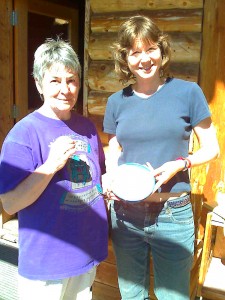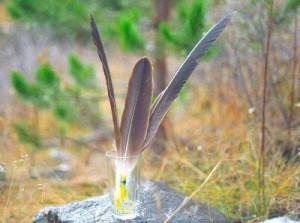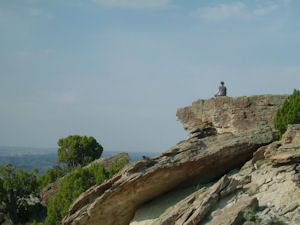 Cowboys, dogs, and dirtbikers: unexpected visitors to Monkey Valley
Cowboys, dogs, and dirtbikers: unexpected visitors to Monkey Valley
The Douglas Lake Cattle Company has the grazing rights for the land all around Monkey Valley. So it is not really surprising that I’ve seen quite a few cows—and a fair number of bulls, too—but that’s another story. It was a real thrill one August morning to see a couple of cowboys, who rode up to the gate to let me know they were bringing the cattle in to graze the piece of land on the other side of the fence. They were on horses, and wore cowboy hats and jingling spurs. Real cowboys!
Kurt was about 15, and the other one, whose name I’ve forgotten, was possibly in his 60s. They were real polite and friendly, and invited me to come visit the cow camp where they all stay for the summer. I never did go, but maybe one year. Now and then over the years I have seen their trucks and horse trailers parked beside the road, when they are in the process of moving cattle from one area to another. In the spring the cows are turned out to graze at low elevations where the snow has melted, and they gradually move higher into the mountains as the summer goes on. In the fall they move back down again. The workers at the cow camp move the cows around, and tend to injured cows and calves as well.
~* Oh, the life of a cowboy is lonely… Campfires and beans, and bitter dark coffee… *~
It’s a way of life that has been romanticized in the movies, and settlers in BC have been raising cattle for up to 120 years. I led a Northwest Earth Institute discussion group on sustainability in Merritt in 2006, and we talked about the kind of land in this area and what food sources it will support. According to one of the participants, whose family has been ranching in this area for decades, the land around Merritt is dry and hilly and supports cattle grazing on the grass but would not be suitable for growing soybeans. I respect her point of view, and think she’s probably right.
However, much of the land on earth that is suited to growing crops and diverse plant life has been razed for cattle grazing to supply us with cheap beef. We’ve all heard from people like John Seed’s Rainforest Rescue organization about how a large percentage of the earth’s rainforests have been burned to the ground. Here’s a plea from Matthew Fox, author of Creation Spirituality: Liberating Gifts for the Peoples of the Earth, from the chapter of the same name in The Soul of Nature (p. 214):
«Today we need to have ecological virtues. For example, vegetarianism or semi-vegetarianism is an ecological virtue. There is no longer any excuse for a human being in the so-called first world not questioning his or her amount of consumption of meat. In fact, if North Americans alone were to cut back just ten per cent in their meat consumption, sixty million humans would eat today who were starving. The amount of land, water, and grain we are using to feed an addictive meat habit is simply unsustainable in our time.»
This is one reason the Monkey Valley Retreat Centre serves vegetarian food.




 nature. In North America, the plains peoples are the most well-known groups to use the ancient practice of the vision quest. John Murray recounts, in editors Michael Tobias and Georgianne Cowan’s
nature. In North America, the plains peoples are the most well-known groups to use the ancient practice of the vision quest. John Murray recounts, in editors Michael Tobias and Georgianne Cowan’s 




